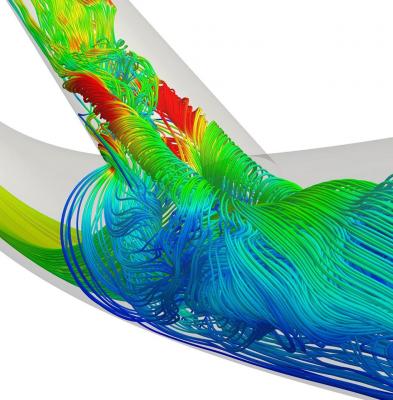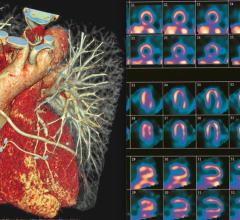
An example of blood flow fluid dynamics showing sheer stresses on the vessel wall. Image courtesy of the British Heart Foundation. It is beleived sheer stress and fluid dynamics inside vessles play a role in vascular disease.
August 16, 2016 — New research from a fluid mechanics team in Greece reveals how blood flow dynamics within blood vessels may influence where plaques develop or rupture. The findings could one day help doctors identify weak spots on a vessel wall that are likeliest to fail, and lead to early interventions in treating heart disease. The study was published this week in Physics of Fluids.
When plaque (fatty deposits that build up on the inside of arteries) rupture and block blood flow, the results can be deadly. Such hardening of the arteries, also called atherosclerosis, typically leads to heart disease, the leading cause of death in the United States. Despite years of therapeutic advances, scientists are still figuring out how and why these deposits develop, searching for a way to reduce the number of heart attacks and strokes.
In the study, the scientists developed a computer-based analytical solution that helps predict sites of vessel failure based on computations of disease-causing flow. They represented the complex blood flow within the heart during a cardiac cycle — the complete sequence of events in the heart from the beginning of one beat to the next.
The research improves predictions of circumferential wall stress or the forces inside the blood vessel compared to other methods. "This is a factor that may contribute … to the faster aging of the arterial system and the possible malfunction of the aorta," said lead researcher Gerasimos A.T. Messaris, a medical physicist at the University Hospital of Patras in Greece.
The team includes investigators from the Medical Physics Department of the University Hospital of Patras, the School of Science and Technology of the Hellenic Open University, and the Division of Theoretical Physics of the Department of Physics of the University of Patras.
The researchers also focused on the role inflow played via a parameter called the Womersley number. In the analysis of a biological fluid such as blood, it pertains to the unsteady parts of flow or the way blood pulses through vessels.
"Our present work is motivated by the fact that blood flow in the aorta and the main arteries is governed by large finite values of the Womersley number α …The existing numerical solutions, although accurate, give limited information about the factors that affect the flow, whereas an analytical approach … can provide physical insight to the flow mechanism," said Messaris.
Identifying likely rupture spots on vessels is crucial for improving heart care for atherosclerotic disease because the plaque-forming cycle of cardiac disease begins with a rupture, or tear, in the vessel walls. This opening allows disease-causing particles to enter the vessel wall layers and progressively grow into plaques that either block the vessel, or cause a catastrophic rupture.
For more information: www.scitation.aip.org



 January 23, 2024
January 23, 2024 








